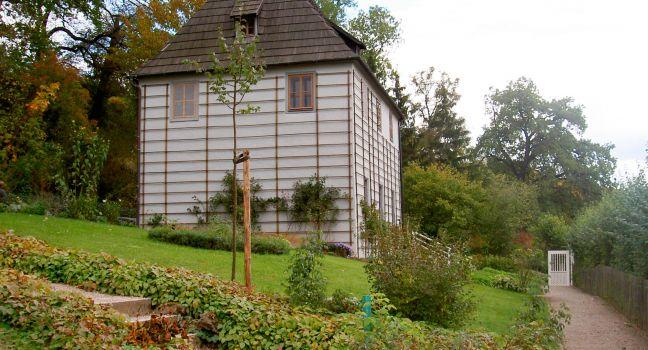Goethe Nationalmuseum
Goethe spent 57 years in Weimar, 47 of them in a house two blocks south of Theaterplatz that has since become a shrine attracting millions of visitors. The Goethe Nationalmuseum consists of several houses, including the
Get FREE email communications from Fodor's Travel, covering must-see travel destinations, expert trip planning advice, and travel inspiration to fuel your passion.
Sorry! We don't have any recommendations for Saxony, Saxony-Anhalt and Thuringia right now.
We’ve compiled the best of the best in Saxony, Saxony-Anhalt and Thuringia - browse our top choices for the top things to see or do during your stay.
Goethe spent 57 years in Weimar, 47 of them in a house two blocks south of Theaterplatz that has since become a shrine attracting millions of visitors. The Goethe Nationalmuseum consists of several houses, including the
Within Lutherhhaus is the Augustinian monastery where Martin Luther lived both as a teacher-monk and later, after the monastery was dissolved, as a married man. Today it's a museum dedicated to Luther and the Reformation. Visitors enter through a garden and an elegant door with a carved stone frame; it was a gift to Luther from his wife, Katharina von Bora. Be sure to visit the monks' refectory, where works by the painter Lucas Cranach the Elder, Luther's contemporary, are displayed. The room that remains closest to the original is the dark, wood-paneled Lutherstube. The Luthers and their six children used it as a living room, study, and meeting place for friends and students. Prints, engravings, paintings, manuscripts, coins, and medals relating to the Reformation and Luther's translation of the Bible into the German vernacular are displayed throughout the house.
The Bach family home, the old Bosehaus, stands opposite the Thomaskirche, and is now a museum devoted to the composer's life and work. The exhibition offers several interactive displays; arranging the instrumental parts of Bach's hymns is by far the most entertaining.
Johann Sebastian Bach was born in Eisenach in 1685. The Bachhaus has exhibits devoted to the entire lineage of the musical Bach family and includes a collection of historical musical instruments. It is the largest collection of Bach memorabilia in the world, and displays a bust of the composer built using forensic science from a cast of his skull. The price of admission includes a 20-minute recital using historical instruments, held once per hour.
Lucas Cranach the Elder—court painter, printer, mayor, pharmacist, friend of Luther's, and probably the wealthiest man in Wittenberg—lived in two houses during his years in town. This Cranachhaus is believed to have been the first one. His son, the painter Lucas Cranach the Younger, was born here. Some of the interior has been restored to its 17th-century condition. It's now a gallery with exhibits about Cranach's life and work. Check out the goldsmith and potter that are occasionally on hand demonstrating their crafts in the courtyard.

Goethe's first house in Weimar, the beloved Gartenhaus, is a modest country cottage where he spent many happy hours, wrote much poetry, and began his masterly classical drama Iphigenie. The house is set amid meadowlike parkland on the bank of the River Ilm. Goethe is said to have felt very close to nature here, and you can soak up the same rural atmosphere on footpaths along the peaceful little river.
This downtown house has many fascinating exhibits illustrating the life of Martin Luther, who lived here as a student. The house hosts a variey of special exhibits that make a visit to this minor Luther site worthwhile.
In this elegantly gabled Renaissance home, the humanist teacher and scholar Philipp Melanchthon corrected Luther's translation of the New Testament from Greek into German. Luther was hiding in the Wartburg in Eisenach at the time, and as each section of his manuscript was completed it was sent to Melanchthon for approval. (Melanchthon is a Greek translation of the man's real name, Schwarzerdt, which means "black earth"; humanists routinely adopted such classical pseudonyms.) The second-floor furnishings have been painstakingly re-created after period etchings.
The only surviving residence of the composer Felix Mendelssohn-Bartholdy is now Germany's only museum dedicated to him. Mendelssohn's last residence and the place of his death has been preserved in its original 19th-century state. Concerts are held every Sunday at 11.
Built in 1890, this is said to be the narrowest house in eastern Germany. Its width is just over 6 feet, 8 inches; its height, 24½ feet; and its depth, 34 feet. The house is interesting to see from the outside, but it is privately owned and not open to the public.
The philosopher Friedrich Nietzsche's family lived in Naumburg from 1858 to 1897, in a small classical house in the Weingarten. The Nietzsche Haus Museum documents the life and times of one of Naumburg's most controversial residents. The exhibition does not delve too deeply into Nietzsche's philosophy, but focuses a great deal on his bizarre relationship with his sister and her manipulation of his manuscripts.
This green-shuttered residence, part of the Goethe Nationalmuseum, is on a tree-shaded square not far from Goethe's house. Schiller and his family spent a happy, all-too-brief three years here (he died here in 1805). Schiller's study is tucked underneath the mansard roof, a cozy room dominated by his desk, where he probably completed Wilhelm Tell. Much of the remaining furniture and the collection of books were added later, although they all date from around Schiller's time.
In the second Wittenberg home of Cranach the Elder, the Renaissance man not only lived and painted but also operated a print shop, which has been restored. The courtyard, where it's thought he did much of his painting, remains much as it was in his day. Local children attend the Malschule (painting school) next to the apothecary.


 Sign up for Travel Tips & News
Sign up for Travel Tips & News
 Thank you for your interest!
Thank you for your interest!